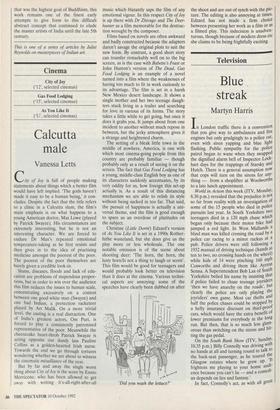Cinema
City of Joy ('12', selected cinemas) Gas Food Lodging ('15', selected cinemas) As You Like It ('U', selected cinemas)
Calcutta male
Vanessa Letts
City of Joy is full of people making statements about things which a better film would have left implied. 'The gods haven't made it easy to be a human being,' it con- cludes. Despite the fact that the title refers to a clinic in a Calcutta slum, the film's main emphasis is on what happens to a young American doctor, Max Lowe (played by Patrick Swayze). His circumstances are extremely interesting, but he is not an interesting character. We are forced to endure Dr Max's repeated emotional temperature-taking as he first resists and then gives in to the idea of practising medicine amongst the poorest of the poor. The poorest of the poor themselves are barely given a credible look-in.
Slums, diseases, floods and lack of edu- cation are problems of stupendous propor- tions, but in order to win over the audience this film reduces the issues to human scale, concentrating excessively on a contest between one good white man (Swayze) and one bad Indian, a protection racketeer played by Art Malik. On a more trivial level, the casting is a real distraction. One of India's greatest actors, Om Puri, is forced to play a consistently patronised representative of the poor. Meanwhile the cheesecake heart-throb Patrick Swayze is acting opposite our dandy lass Pauline Collins as a golden-hearted Irish nurse. Towards the end we go through tortures wondering whether we are about to witness the cinematic mesalliance of the year. But by far and away the single worst thing about City of Joy is the score by Ennio Morricone, who has been allowed to get away with writing it's-all-right-after-all music which blatantly saps the film of any emotional vigour. In this respect City of Joy is up there with Dr Zhivago and The Deer- hunter as a film memorable for the destruc- tion wrought by the composer.
Films based on novels are often awkward and badly constructed because the adapters daren't savage the original plots to suit the new form. By contrast, a good short story can transfer remarkably well on to the big screen, as is the case with Babette's Feast or John Huston's version of The Dead. Gas Food Lodging is an example of a novel turned into a film where the weaknesses of having too much to fit in work curiously to its advantage. The film is set in a harsh New Mexico desert landscape. It shows a single mother and her two teenage daugh- ters stuck living in a trailer and searching for love in various of its forms. The story takes a little while to get going, but once it does it grabs you. It jumps about from one incident to another without much repose in between, but the jerky atmosphere gives it a strange and heightened charm.
The setting of a bleak little town in the middle of nowhere, America, is one with which most cinema-going people from this country are probably familiar — though probably only as a result of seeing it on the screen. The fact that Gas Food Lodging has a young, middle-class English boy as one of its characters suddenly accentuates, by its very oddity for us, how foreign this set-up actually is. As a result of this distancing mechanism we are able to relish its style without being sucked in too far. That said, the pursuit of happiness is actually a uni- versal theme, and the film is good enough to spare us an overdose of platitudes on the subject.
Christine (Little Dorrit) Edzard's version of As You Like It is set in a 1990s Rother- hithe wasteland, but she does give us the play more or less wholesale. The one notable omission is of the scene about shooting deer: 'The horn, the horn, the lusty horn/Is not a thing to laugh or scorn'. This film would be good for teenagers and would probably look better on television than it does at the cinema. Various techni- cal aspects are annoying: some of the speeches have clearly been dubbed on after 'Did you wash the lettuce?' the shoot and are out of synch with the pic- ture. The editing is also annoying at times. Edzard has not made a firm choice between presenting her work as a film or as a filmed play. This indecision is unadven- turous, though because of modern dress etc she claims to be being frightfully exciting.


























































 Previous page
Previous page